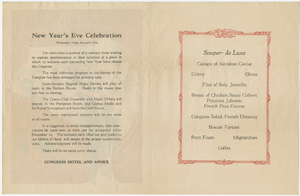Search the Special Collections and Archives Portal
Search Results

Transcript of interview with Joy Snyder by Lisa Gioia-Acres, December 17, 2009
Date
Archival Collection
Description
Joy Snyder, born and raised in Pennsylvania, is the daughter of Jean Dasinto and stepdaughter of Ray Hunt. Though she was raised thinking she was an only child, she shares that as an adult, she was contacted by an aunt who gave her information about an Austrian half-sister. The half-sister had tracked the family through WWII records on her biological father! Joy was raised in a very large extended Italian family (her maternal grandmother was first-generation Italian) and became the first in her family to attend college. She had decided early on that she wanted to be a nurse and chose to attend Temple University Hospital in Philadelphia. She recounts memories of her earliest work there, which began the first week of school. After graduation from nursing school, Joy married her childhood sweetheart, William (Bill) Snyder. They made the move to Las Vegas in 1978 and Joy found work right away at Desert Springs Hospital. She worked there about six months and then took maternity leave after the birth of their second son. When she returned to work, it was at Sunrise Hospital (early 1979) in the newborn nursery. Joy comments on many aspects of her career, including the informal approach to health care, the effects of desert climate on mothers and newborns, and the changes she has seen at Sunrise Hospital. She also comments on adoption practices in Las Vegas, drug-addicted babies, and cultural attitudes that appear during the birthing process. Today Joy is retired and her husband Bill is close to retiring. They feel a strong connection to Las Vegas (Bill has a school named after him), but maintain a second home in New York for their trips back East to visit friends and family. They also keep up with various community activities, including book clubs and running clubs for the children at William Snyder Elementary School.
Text
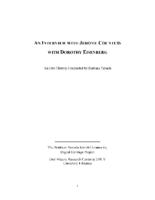
Transcript of interview with Jerome Countess and Dorothy Eisenberg by Barbara Tabach, October 28, 2014
Date
Archival Collection
Description
Interview with Jerry Countess and Dorothy Eisenberg by Barbara Tabach on October 28, 2014. Countess discusses his childhood and military life. He became involved in the United Jewish Appeal in Las Vegas and started the Jewish Reporter newspaper. Dorothy Eisenberg is also involved in the interview to discuss the Jewish Federation and the Jewish community.
Jerome Countess, known as Jerry to most, was born on December 22, 1920 in Brooklyn, New York. He grew up in the borough's Jewish neighborhood, and he developed a reputation for being a skillful handball player and a great dancer. Though he was not allowed to enlist in the U.S. Coast Guard due to colorblindness, Jerry was eventually drafted into the army during World War II. With very minimal combat training, Jerry was sent to North Africa as an infantryman, and was later stationed in Italy. After three years of service, Jerry returned home and married his childhood sweetheart, Rachel, in 1945. Using the G.I. Bill, he enrolled at New York University to study writing, though he quit just shy of graduation as his wife was expecting. After briefly working in the television broadcasting industry, Jerry landed a job with the United Jewish Appeal. In 1975, following in his desire to move west, Jerry took the job of executive director of the Combined Jewish Appeal in Las Vegas, what would soon be renamed the Jewish Federation of Las Vegas. Under his leadership, the federation started the Jewish Family Service as well as The Jewish Reporter, a monthly publication to promote engagement of the Jewish community. Jerry served as the executive director of the federation for many years, serving at the pleasure of many board members and presidents, including the first female federation president, Dorothy Eisenberg.
Text
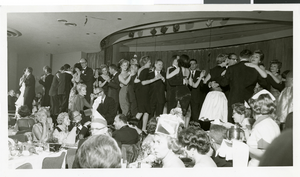
Photograph of guests dancing in the Copa Showroom, Las Vegas, circa 1950s-1960s
Date
Archival Collection
Description
Image
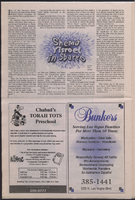
Chabad Times newspaper of Chabad of Southern Nevada, 2000-2002
Date
Archival Collection
Description
Issues of Chabad Times, a publication of Chabad of Southern Nevada, for the years 2000, 2001, and 2002. The newspaper includes information and photographs about local events, advertisements, advice columns, and general interest articles.
Text
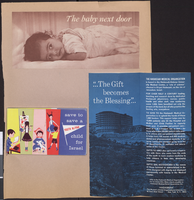
Scrapbook pages from the Las Vegas Chapter of Hadassah, 1970-1971
Date
Archival Collection
Description
This folder contains loose scrapbook pages from the Las Vegas Chapter of Hadassah for the years 1970 and 1971. The pages document events of the chapter, including fundraising activities, meeting announcements and newspaper clippings.
Mixed Content
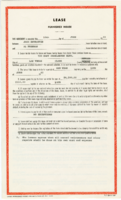
Lease for a furnished house between Jack Entratter and Al Freeman in Las Vegas, June 16, 1965
Date
Archival Collection
Description
Text
Juanita Fain oral history interview
Identifier
Abstract
Oral history interview with Juanita Fain conducted by Claytee D. White on November 19, 2021 for the African Americans in Las Vegas: A Collaborative Oral History Project. In this interview, Fain recalls her childhood in Newark, New Jersey and earning a doctorate degree in Higher Education administration from The Ohio State University. After she was hired by Carol Harter at Ohio State in 1980 as Director of Financial Aid, she came to the University of Nevada, Las Vegas (UNLV) in 1996 as Dean of Enrollment and Management. After various positions, she became Vice President of Student Affairs and in 2021, Interim Chief Diversity Officer was added to her responsibilities. Fain will retire in 2023 after serving her final year as a Special Liaison to President Whitfield.
Archival Collection

Film transparency of the Boulder Dam Power Decennial plaque, October 25, 1946
Date
Archival Collection
Description
Image


